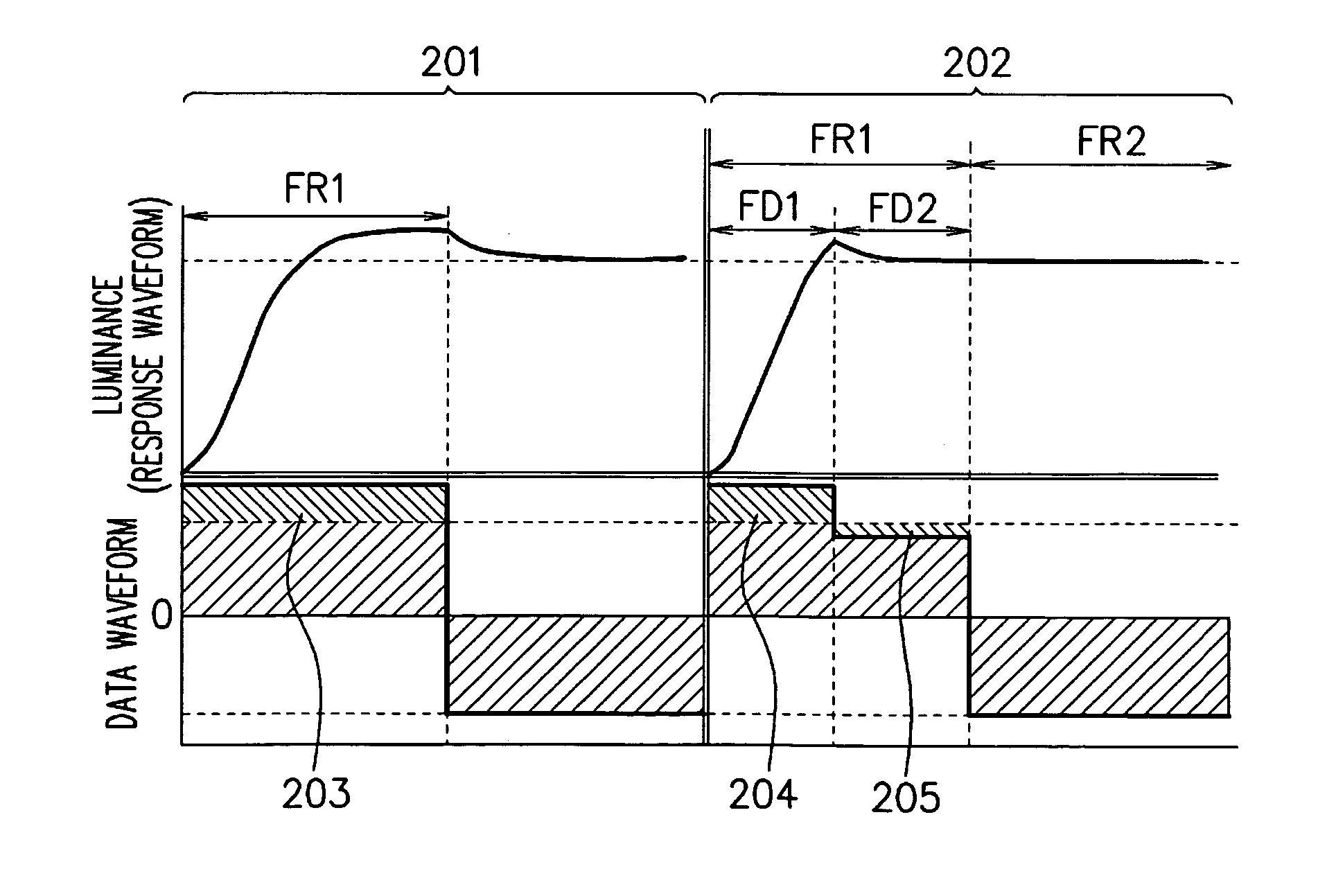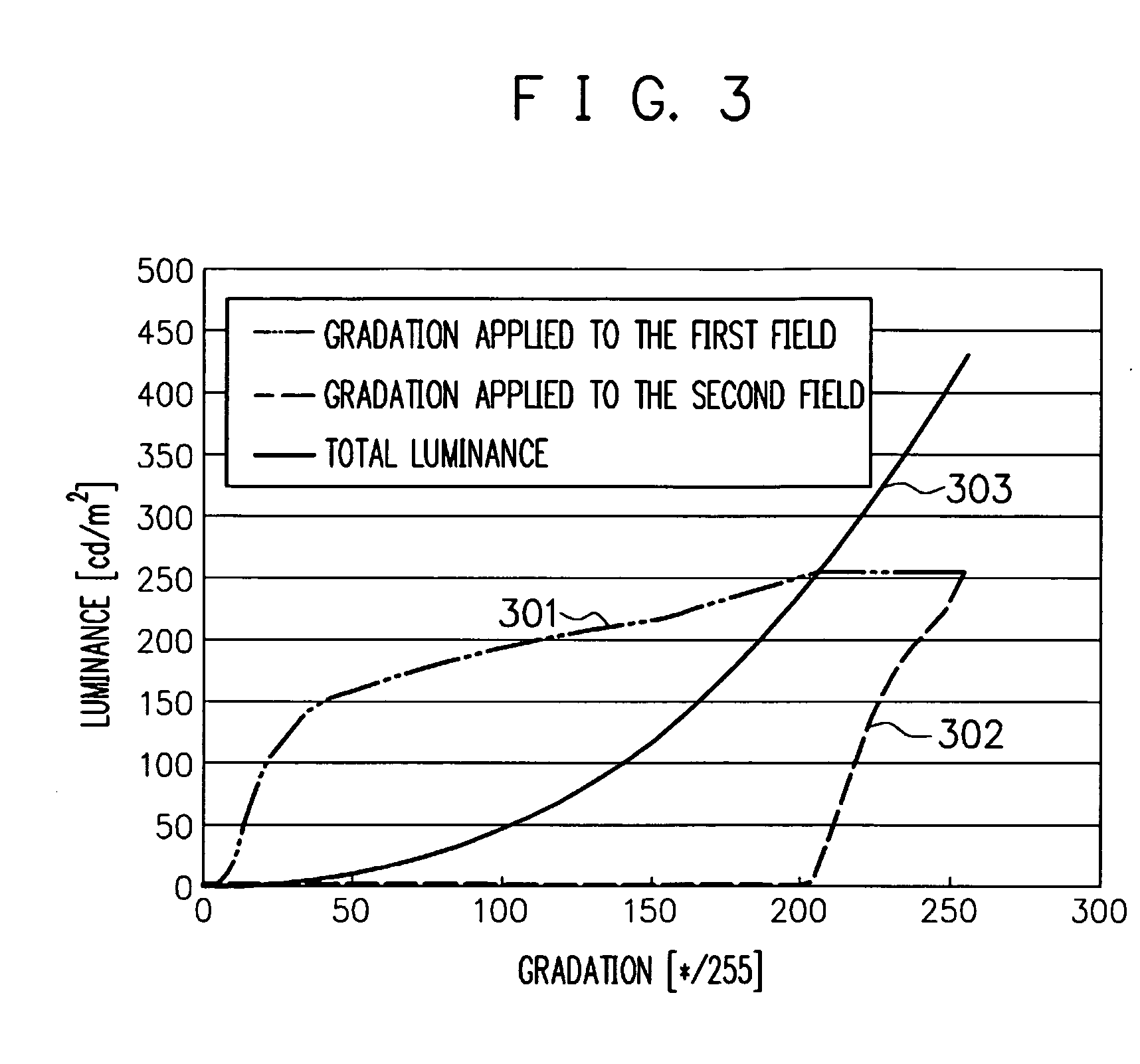Liquid crystal display device
a liquid crystal display and display device technology, applied in the field of liquid crystal display devices, can solve the problems of affecting the quality of the movie, the voltage value is limitative, and the movie is known to be inferior, so as to improve the gradation-viewing angle characteristics, shorten the response time, and improve the effect of the response tim
- Summary
- Abstract
- Description
- Claims
- Application Information
AI Technical Summary
Benefits of technology
Problems solved by technology
Method used
Image
Examples
first embodiment
[0038]FIG. 1 is a drawing showing an exemplary configuration of the liquid crystal display device according to the first embodiment of the present invention. A timing controller 104 has a data converter 105, allowing itself to write and read to and from a memory 106. A data converter 105 divides one frame into a plurality of fields, and converts a frame data into a field data. A gate driver 102 supplies, by fields, a gate pulse voltage to gate lines (scanning lines) in a liquid crystal panel 101, under control by a timing controller 104. The gate lines are lines for selecting pixels. A data driver 103 supplies, by fields, a data voltage to data lines (signal lines) in the liquid crystal panel 101, under control by the timing controller 104. The data lines are lines for supplying pixel data. The liquid crystal panel 101 has an array substrate on which a plurality of gate lines and a plurality of data lines are crossed thereon, and an active element (TFT: thin film transistor) is form...
second embodiment
[0046] The first embodiment has aimed at improving the response speed by applying the same data, as the pre-conversion data, to the first field FD1 and the second field FD2, whereas the second embodiment of the present invention will deal with the case where different pre-conversion data will be applied to the first field FD1 and the second field FD2.
[0047] As the data voltage, V1 is applied to the low-gradation first field FD1, and the black-level voltage (minimum gradation value) Vb are applied to the second field FD2. On the high gradation side, the white-level voltage Vw is applied to the first field FD1, and V3 is applied to the second field. The individual voltage values are selected so that target luminance values can be achieved for the individual frames, by time integral of data voltages V1 and Vb on the low gradation side, and of data voltages Vw and V3 on the high gradation side.
[0048]FIG. 3 is a drawing showing relations between the gradation and the luminance. A chara...
third embodiment
[0063] Division of one frame into two fields can also shorten the write time to the pixels. In 60-Hz operation, the gate pulse time in the normal operation under the XGA resolution is given as 1 / 60 / 768=21.7 μs, whereas division into two fields gives a halved gate pulse time of 10.9 ξs. The gate pulse is applied to the gate lines in a field-by-field manner. It is apparent that one frame divided by n fields can further shorten the gate pulse time.
[0064] A problem possibly raised herein relates to write ability of the TFT. Division of one frame into two fields is aimed at improving the response speed, whereas an insufficient state of write operation is not only unsuccessful in improving the response speed, but also unsuccessful in compensating variation in the driving ability of TFT depending on environment in which the liquid crystal panel is placed, and in ensuring reliability.
[0065] In this case, a multi-scanning operation of the gates is adopted as a method of ensuring a sufficie...
PUM
 Login to View More
Login to View More Abstract
Description
Claims
Application Information
 Login to View More
Login to View More - R&D
- Intellectual Property
- Life Sciences
- Materials
- Tech Scout
- Unparalleled Data Quality
- Higher Quality Content
- 60% Fewer Hallucinations
Browse by: Latest US Patents, China's latest patents, Technical Efficacy Thesaurus, Application Domain, Technology Topic, Popular Technical Reports.
© 2025 PatSnap. All rights reserved.Legal|Privacy policy|Modern Slavery Act Transparency Statement|Sitemap|About US| Contact US: help@patsnap.com



